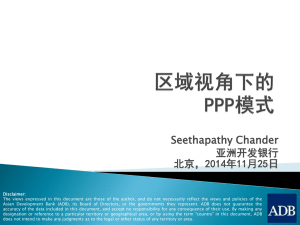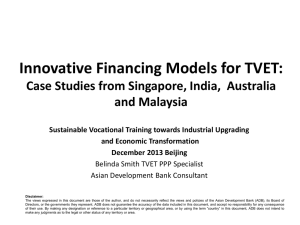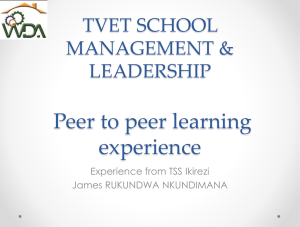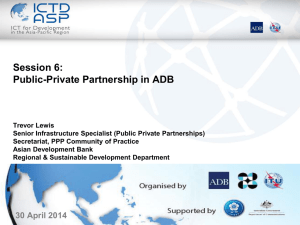- rksi.org
advertisement
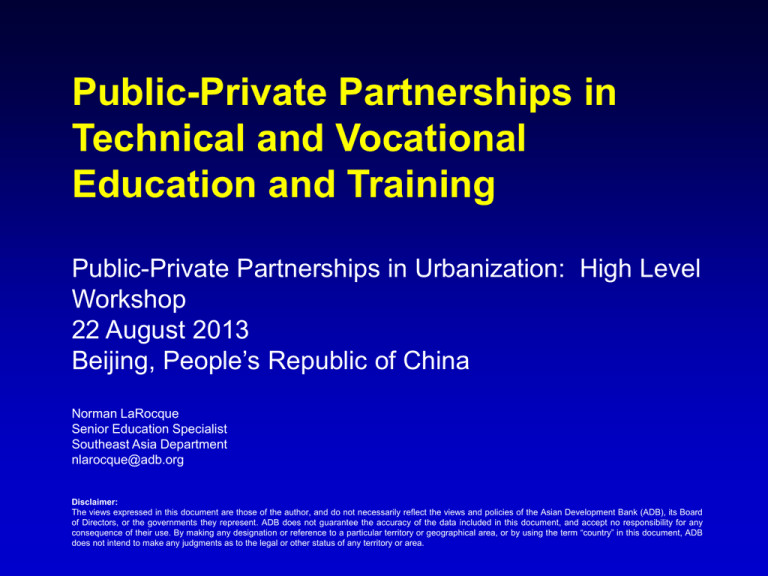
Public-Private Partnerships in Technical and Vocational Education and Training Public-Private Partnerships in Urbanization: High Level Workshop 22 August 2013 Beijing, People’s Republic of China Norman LaRocque Senior Education Specialist Southeast Asia Department nlarocque@adb.org Disclaimer: The views expressed in this document are those of the author, and do not necessarily reflect the views and policies of the Asian Development Bank (ADB), its Board of Directors, or the governments they represent. ADB does not guarantee the accuracy of the data included in this document, and accept no responsibility for any consequence of their use. By making any designation or reference to a particular territory or geographical area, or by using the term “country” in this document, ADB does not intend to make any judgments as to the legal or other status of any territory or area. Types of Education PPPs • Three main types of education PPPs to be discussed today: – Service delivery PPPs: • • Government contracts with private operators to deliver teaching services Government contracts with private operators to manage public schools and TVET institutes – Contracting with the private sector for the provision of school/TVET institute infrastructure – Voucher/subsidy programs • Focus on technical and vocational education and training (TVET) sector Examples of Education and Training PPPs Type Examples Basic/Secondary Education Service Delivery PPPs: • Contracting for the Delivery of Education Services • Education Service Contracting, Philippines • Foundation Assisted Schools, Pakistan • Gyanodaya Senior Secondary Schools, India • Promoting Private Schooling in Rural Sindh, Pakistan (World Bank Project) • • • Private • Management • of Public Schools/Institutes • • Concession Schools, Colombia Independent Schools, Qatar Charter/Contract schools, USA Khazanah Trust Schools, Malaysia Partnership Schools, NZ Free Schools, UK TVET • Skills Contracting Program, Lao PDR (ADB Project) • Reform of Technical and Vocational Training, KSA • Specialist Skills Contracting Program, Lao PDR (ADB Project) • Basic/mid-level Skills Training Program, Nepal (ADB Project) • Mid-Level Skills Training Project, Timor-Leste (ADB Project) • Penang Skills Development Center, Malaysia (Hybrid) Examples of Education and Training PPPs Partnership Infrastructure PPPs Examples • • • • • Basic/Secondary Education Private Finance Initiative, UK PPPs for new school property, NZ Alberta Schools Alternative Procurement/New Schools Project, Alberta, Canada New Schools PPP, NSW, Australia PPP for School Infrastructure Project, Philippines • • • • TVET Southbank Institute of Technology, Queensland, Australia ITE College West, Singapore Build-Transfer-Lease Program, South Korea Lao National Institute of Hospitality and Tourism, Lao PDR (Proposed) Voucher/Subsidy • PACES voucher program, Colombia • Training Assistance Voucher Program, Lao PDR (ADB Programs • Voucher scheme, Chile Project) • Voucher Scheme, Qatar • Senior High School Voucher Program, Philippines (Proposed) Strengthening Technical and Vocational Education and Training Project, Lao PDR • • ADB project (approved 2010) Significant use of PPPs: – – – – Training assistance voucher program for public and private institutes Strengthened industry involvement in development of skill standards/curriculum Contracting with private firms to deliver training in high cost skill areas Direct contracting with private TVET institutes for course/program delivery Basic/Mid-level Skills Training Program, Nepal • ADB project (approved 2013) • Objective - close skills gap by providing basic or midlevel skills for people with low formal educational attainment and limited work experience • Training and employment services provided by private and public providers • Pay for performance – 50% of contract payment made based on verification of employment outcomes • About 36,000 seats will be delivered by private training providers during life of project Reform of Technical and Vocational Training, Kingdom of Saudi Arabia • • • Expansion of TVET system from 100,000+ to 450,000+ students by 2020 Improved quality of training Transition to PPP model: − Government will oversee and regulate training provision − Training institutes will be operated by private sector − Significant involvement of private sector in curriculum/standards development − Approximately 10 new PPP colleges with capacity of 25,000 students to be set up in 2013, with further ones established later Penang Skills Development Center, Malaysia • • • • • • • Established 1989 Industry-led training center Located within the Free Industrial Zones Tripartite model - industry, academia, government Provides training and educational programs, advice on technological progress Courses from Certificate to Masters level 150,000+ trainees to date Penang Skills Development Center, Malaysia • Private and public finance • Registered as an Institution of Higher Learning and Private Higher Education Institution in Malaysia • Pool resources of 4 Free Trade Zones and 4 Industrial Estates in Penang (775 factories, 170,000+ workers) • Private sector managed • Not-for-profit entity Build-Transfer-Lease System, Korea • • • • Build-Transfer-Lease (BTL) system introduced in school sector in 2005 – modelled on UK and Australian models Governed by The Act on PPPs in Infrastructure Key features: – Private contractors finance, design, build and operate schools for a period of 20 or more years – Government makes lease payments to private sector – Facilities transferred to the public sector upon completion of the contract – Core services provided by the Government Covers all levels of education – 3 BTL projects completed at technical college level Proposed Lao National Institute of Tourism and Hospitality PPP, Vientiane, Lao PDR • Not-for-profit training institute • Curriculum benchmarked on ASEAN good practice and competency standards • Key elements: – – – – – Government of Lao provides free land to LuxDevelopment LuxDevelopment constructs and operates training institute on ½ of land Private company operates commercial hotel on other ½ of land under concession from Government – no lease payment Payment in lieu of lease payment made by hotel operator directly to training institute to finance its operation Training institute financed by tuition fees, hotel payment and other revenues Potential Benefits of PPPs in TVET • • Potential benefits from PPPs including: – Increased financial resources for TVET sector – Increased access to TVET – Overcome public service operating restrictions - eg. obsolete salary scales, restrictive civil service work rules – Increased relevance of TVET programs – Bring new skills to the TVET sector – Good instrument for targeting assistance – eg. girls/women – Sustainability of outcomes Need well-designed policy framework and institutional governance to implement effectively Conclusions • • • • • Variety of policy objectives – improved quality, greater relevance to labor market needs, increased efficiency, better sector management, etc Many potential PPP models – suit different country and developmental contexts Context important PPP common characteristics: ‒ Government as funder/regulator, Per-student funding ‒ Autonomous management, Accountability, Outcomes focused PPPs do not mean government shirking its responsibilities Good regulation is critical: ‒ Promote innovation ‒ Incentivize private sector ‒ Avoid unintended consequences ADB Education Website www.adb.org/education
